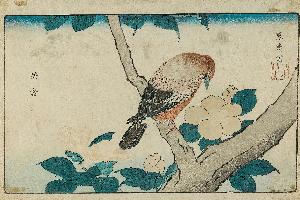Kitao Shigemasa
北尾 重政;Kitao Shigemasa
Place: Edo
Born: 1739
Death: 1820
Biography:
Kitao Shigemasa was a Japanese ukiyo-e artist from Edo, born in 1739 and passed away in 1820. He was one of the leading printmakers of his day, but his works have been slightly obscure. Shigemasa is noted for his images of beautiful women, known as bijinga, and was taught by the renowned artist Shigenaga. He has been referred to as 'a chameleon' who adapted to changing styles, making him a unique and fascinating artist.
Early Life and Career
Shigemasa was born in Edo, Japan, and began his career as an artist at a young age. He was taught by Shigenaga, who was a prominent artist of the time, and quickly developed his own style. Shigemasa's early works were influenced by the traditional ukiyo-e art form, but he soon began to experiment with new techniques and styles.
Artistic Style and Notable Works
Shigemasa's artistic style is characterized by his use of bold lines and vibrant colors. His images of beautiful women, known as bijinga, are particularly notable for their elegance and sensuality. Some of his notable works include Sparrowhawk and camellia, which can be found at the Museo de Bellas Artes de Bilbao in Spain. This painting showcases Shigemasa's ability to capture the beauty of nature and the human form. Shigemasa's work can also be compared to that of other notable artists, such as Tsukioka Yoshitoshi, who was also a prominent ukiyo-e artist. Yoshitoshi's works, such as Taira and Akashi, can be found on Wikioo.org and showcase the artist's ability to capture the beauty of Japanese culture.
Influence and Legacy
Shigemasa's influence on the art world can be seen in the many artists who followed in his footsteps. His unique style and ability to adapt to changing styles have made him a beloved and respected artist. Shigemasa's legacy can be seen in the many ukiyo-e artists who have been inspired by his work, including Utagawa Toyokuni, who is known for his beautiful woodblock prints. Some of Shigemasa's notable contemporaries include Shōgetsu Toshu, who was also a Japanese woodblock print artist. Toshu's works, such as his depictions of historical events and scenes, can be found on Wikioo.org and showcase the artist's ability to capture the beauty of Japanese culture.
- Kitao Shigemasa's works can be found on Wikioo.org
- Shigemasa's notable works include Sparrowhawk and camellia
- Shigemasa was influenced by the traditional ukiyo-e art form
- Shigemasa's legacy can be seen in the many ukiyo-e artists who have been inspired by his work
Shigemasa's life and career are a testament to the enduring power of art to capture the beauty of the human form and the natural world. His unique style and ability to adapt to changing styles have made him a beloved and respected artist, and his legacy continues to inspire artists to this day.


